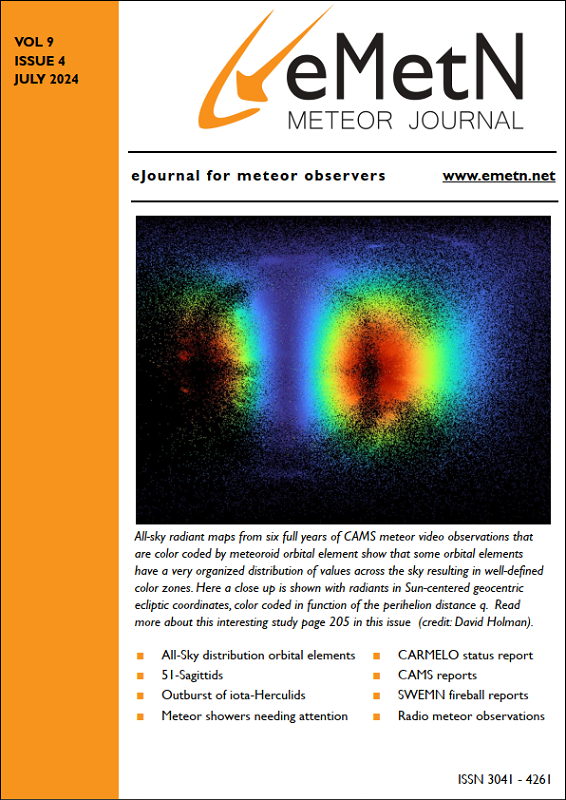On the following morning (May 6), I observed for two hours under a crystal clear sky. It was a comfortable night with only the sound of spring peeper frogs and nocturnal birds! The Eta Aquariids (ETA) seemed a bit less active with 5 seen. The first ETA was an impressive 50 degrees long earth grazer that moved horizontally near the treeline through the Milky Way and below Jupiter. The brightest was a mag -2 ETA at 4:11 am (local time) — a gorgeous yellow-green meteor that had a 30 degrees path and left a 3 sec train! The Eta Lyrids (ELY) were again active in small numbers along with the Antihelion source. The highlight was the appearance of the International Space Station (ISS) with SpaceX Dragon resupply spacecraft. Both objects were seen flying in close formation just hours before docking!
May 5/6 2019, 06:54-08:52 UT (02:54-04:52 EDT)
Location: Bootland Farm (Stewartville), Ontario, Canada
(45°23’N 76°29’W)
Observed showers:
Antihelion (ANT) – 15:48 (237) -20
eta Lyrids (ELY) – 19:04 (286) +43
eta Aquariids (ETA) – 22:25 (336) -02
06:54-07:54 UT (02:54-03:54 EDT); clear; 3/5 trans; F 1.00; LM 6.30; facing SE50 deg; teff 1.00 hr, temp +8C
ETA: two: +1; +5
ANT: two: +2; +4
ELY: two: +3; +5
Sporadics: four: +3(2); +4(2)
Total meteors: Ten
07:54-08:52 UT (03:54-04:52 EDT); clear; 3/5 trans; F 1.00; LM 5.75; facing SE65 deg; teff 0.97 hr, temp +6C
ETA: three: -2; +3; +4
ANT: one: -2
ELY: one: +4
Sporadics: none
Total meteors: Five

Bright sporadic meteor passes below Jupiter.
Morning of May 6, 2019. Stewartville, Ontario
Photographed with a Canon 6D (15 sec exposure, ISO 3200) and Rokinon 14mm f/2.8 lens. By Pierre Martin.
Morning of May 6, 2019. Stewartville, Ontario
Photographed with a Canon 6D (15 sec exposure, ISO 3200) and Rokinon 14mm f/2.8 lens. By Pierre Martin.

Possible Eta Lyrid meteor.
Morning of May 6, 2019. Stewartville, Ontario
Photographed with a Canon 6D (15 sec exposure, ISO 3200) and Rokinon 14mm f/2.8 lens. By Pierre Martin.
Morning of May 6, 2019. Stewartville, Ontario
Photographed with a Canon 6D (15 sec exposure, ISO 3200) and Rokinon 14mm f/2.8 lens. By Pierre Martin.

Bright Eta Aquariid meteor shooting up in the morning twilight into the “Summer Triangle”!
Morning of May 6, 2019. Stewartville, Ontario
Photographed with a Canon 6D (15 sec exposure, ISO 3200) and Rokinon 14mm f/2.8 lens. The halos around stars are due to the lens starting to fog up. By Pierre Martin.
Morning of May 6, 2019. Stewartville, Ontario
Photographed with a Canon 6D (15 sec exposure, ISO 3200) and Rokinon 14mm f/2.8 lens. The halos around stars are due to the lens starting to fog up. By Pierre Martin.


